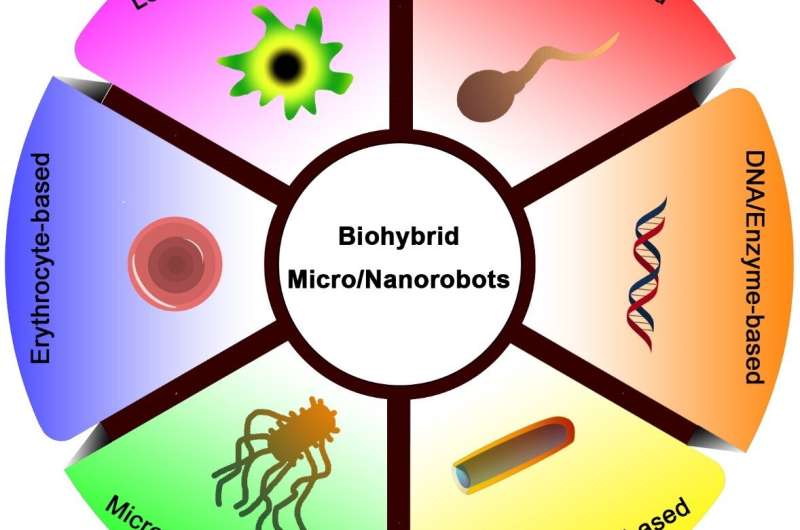
A review paper by scientists at the Beijing Institute of Technology summarized recent advancements in use of intelligent biohybrid micro- and nanorobots for human medical applications.
The new review paper, published on Feb. 10 in the journal Cyborg and Bionic Systems, provided an overview of how tiny robots with living parts are designed and fabricated to perform tasks such as effectively delivering drugs to body tissues.
“These biohybrid micro- and nanorobots are being widely investigated in the field of smart drug delivery for precision therapy of cancer and other diseases,” explained study author Jinhua Li , a professor at the Beijing Institute of Technology.
The emerging field of micro robotics encompasses research and development of robots on a micron size scale for real-world applications. “This emerging research field has received ever-increasing attention, especially after molecular machines were selected as the topic of the Nobel Prize in Chemistry 2016,” said study authors. The biohybrid microrobots they reviewed have both living biological components and nonliving components; typically, an artificial carrier swims or crawls to transport living components to where they perform tasks in the human body.
Biohybrid micro- and nanorobots promise to revolutionize medicine because they can be remote controlled to perform a biochemical operation with high precision. Besides cancer treatment, these robots could play roles in other small-scale tasks such as microsurgery of cells, assisted fertilization, and tissue engineering. “The application scenarios of biohybrid micro- and nanorobots can be expanded from currently focused cancer treatment to many other research fields,” said Li.
The newly published review analyzed the potential uses of various biohybrid robots. They range from about 1 μm to about 20 μm in size, with the variation largely stemming from their components. For example, on the small (nano) end, a DNA-based robot can deliver the blood-clotting agent thrombin to stop the flow of blood to a cancer tumor cell. On the larger (micro) end, a sperm-based robot can deliver the anticoagulant heparin to treat a circulatory system disease.
The study authors grouped biohybrid micro- and nanorobots into six functional categories: leukocyte-based; erythrocyte-based; microorganism-based; cytomembrane-based; DNA/enzyme-based; and sperm-based. Platelet microrobots, for example, have a long circulation time in the bloodstream that allows them to accumulate and deliver drugs to a targeted tissue. Leukocyte microrobots, built of immune cells, have the unique ability to chemotactically navigate to an infection to deliver drugs.
Looking forward, the team envision incorporating novel biological components into biohybrid robots. For example, when a robot is introduced, one challenge is to overcome the human immune response. If bacteria already in a person’s body were instead harnessed to perform therapeutic tasks, that could alleviate an immune response as well as the risk of introducing pathogens.
Another challenge is the efficiency of manufacturing the tiny, nonliving carriers. Future research and development will likely yield novel ways of transporting the biological parts around, such as magnetic fields or light; advancements in techniques for fabricating the nonliving parts; and enhanced imaging techniques such as MRIs and magnetic particle imaging. Researchers expect biohybrid robots to become even more sophisticated and specialized for carrying out complex medical tasks.
“The research field of biohybrid micro- and nanorobots for drug delivery is still in its infancy,” said Li, explaining that most studies have been done in the laboratory with few studies in humans. Biohybrid robots could be useful in many aspects of medicine, including cell microsurgery, gene therapy, and engineering to repair or replace damaged tissues. The review paper calls for researchers, medical professionals, engineers, and other experts to collaboratively marshal the research on biohybrid micro robots into practical applications in clinical settings.
Personalized microrobots swim through biological barriers, deliver drugs to cells
Jinhua Li et al, Biohybrid Micro- and Nanorobots for Intelligent Drug Delivery, Cyborg and Bionic Systems (2022). DOI: 10.34133/2022/9824057
Provided by
Beijing Institute of Technology Press
Citation:
Tiny biohybrid robots for intelligent drug delivery (2022, March 2)
retrieved 2 March 2022
from https://medicalxpress.com/news/2022-03-tiny-biohybrid-robots-intelligent-drug.html
This document is subject to copyright. Apart from any fair dealing for the purpose of private study or research, no
part may be reproduced without the written permission. The content is provided for information purposes only.
Credit: Source link




















